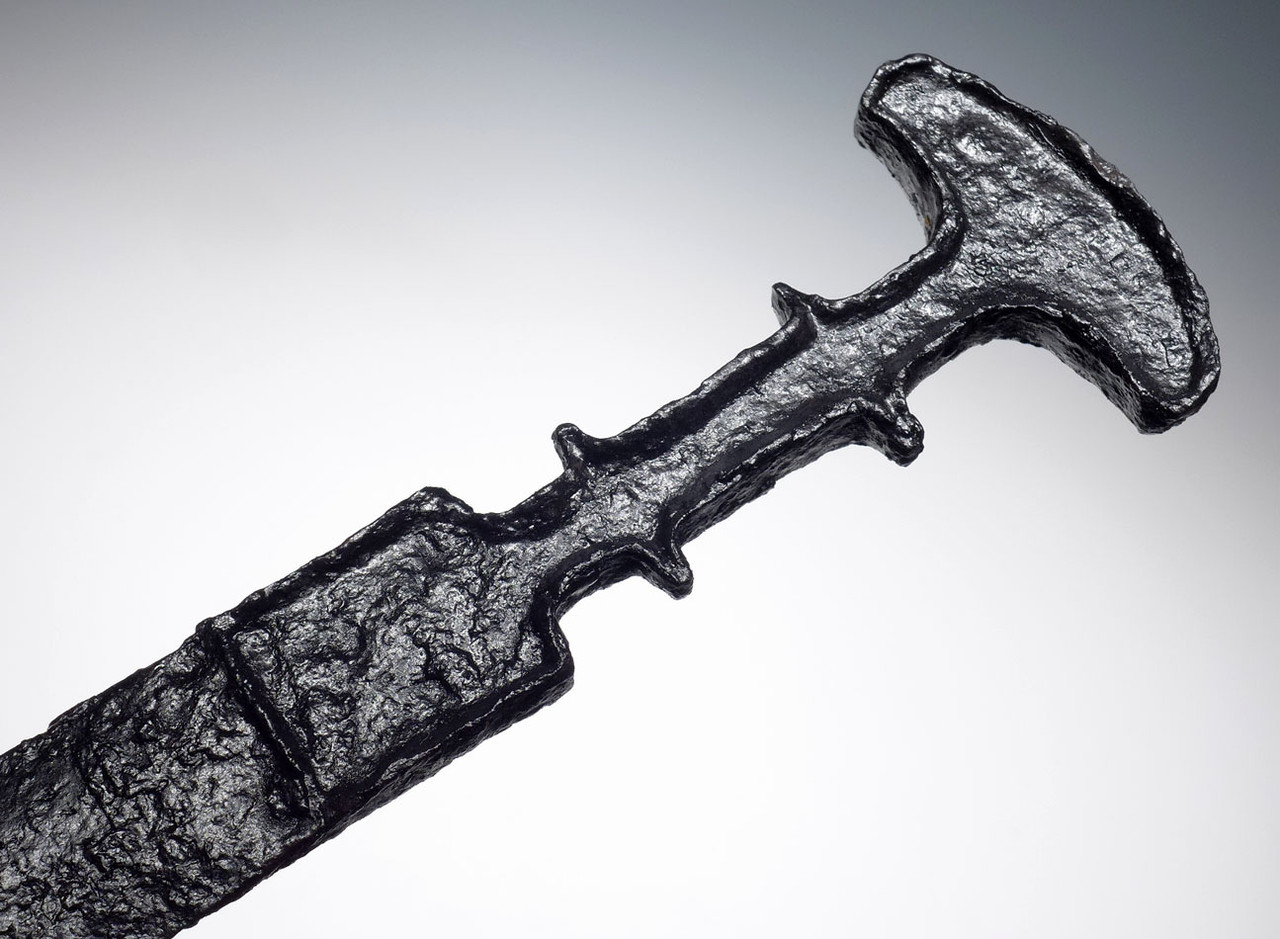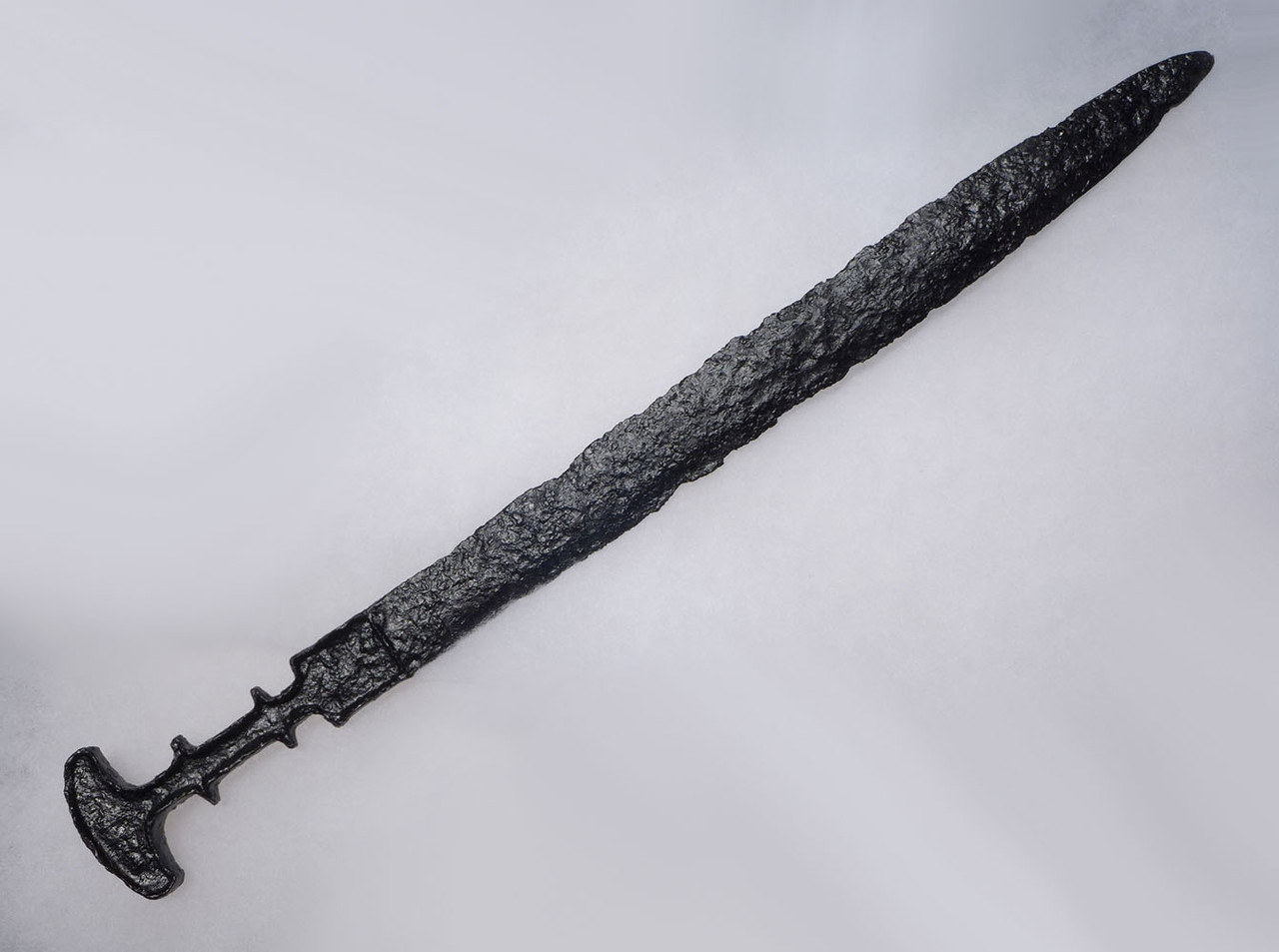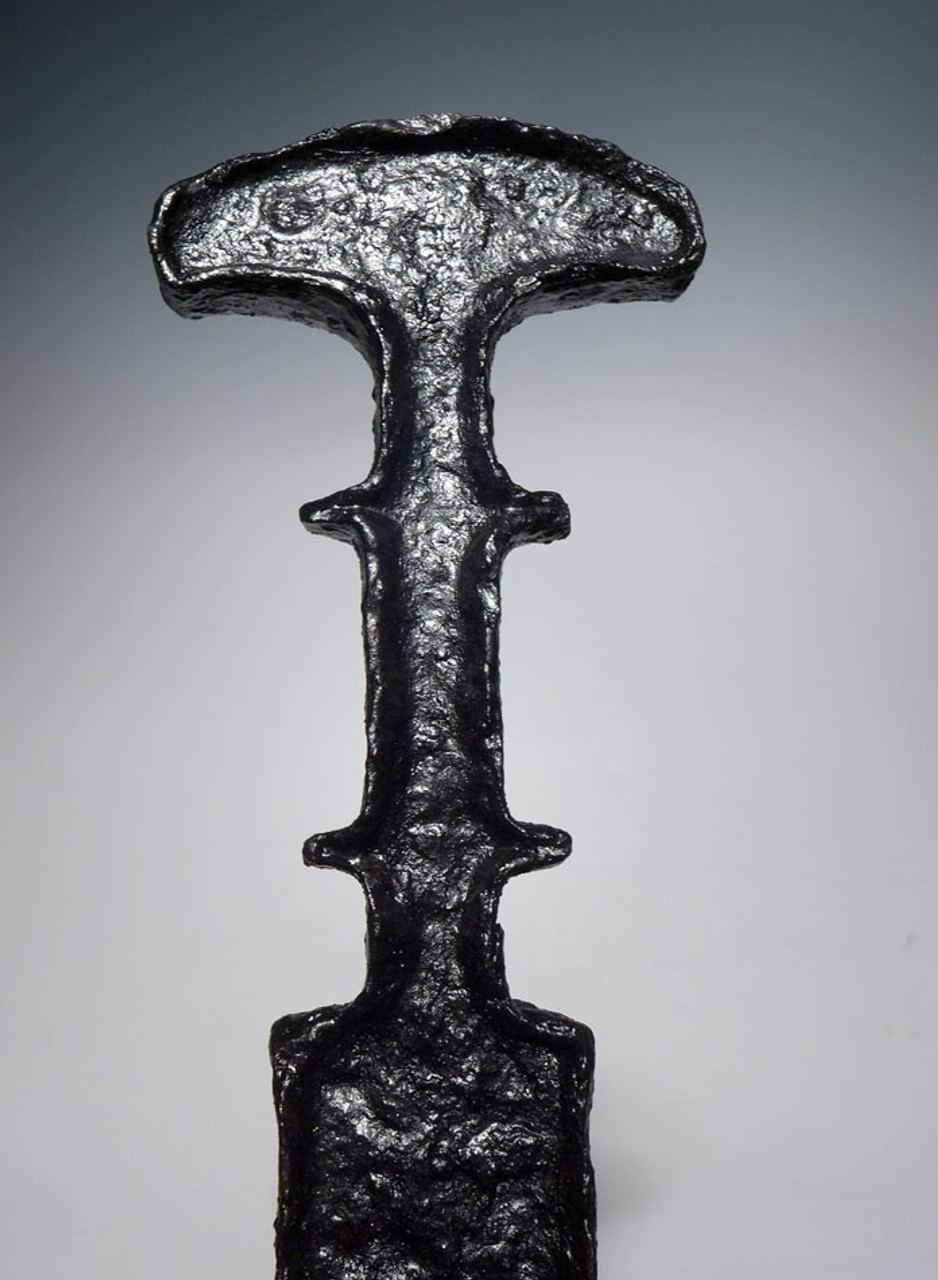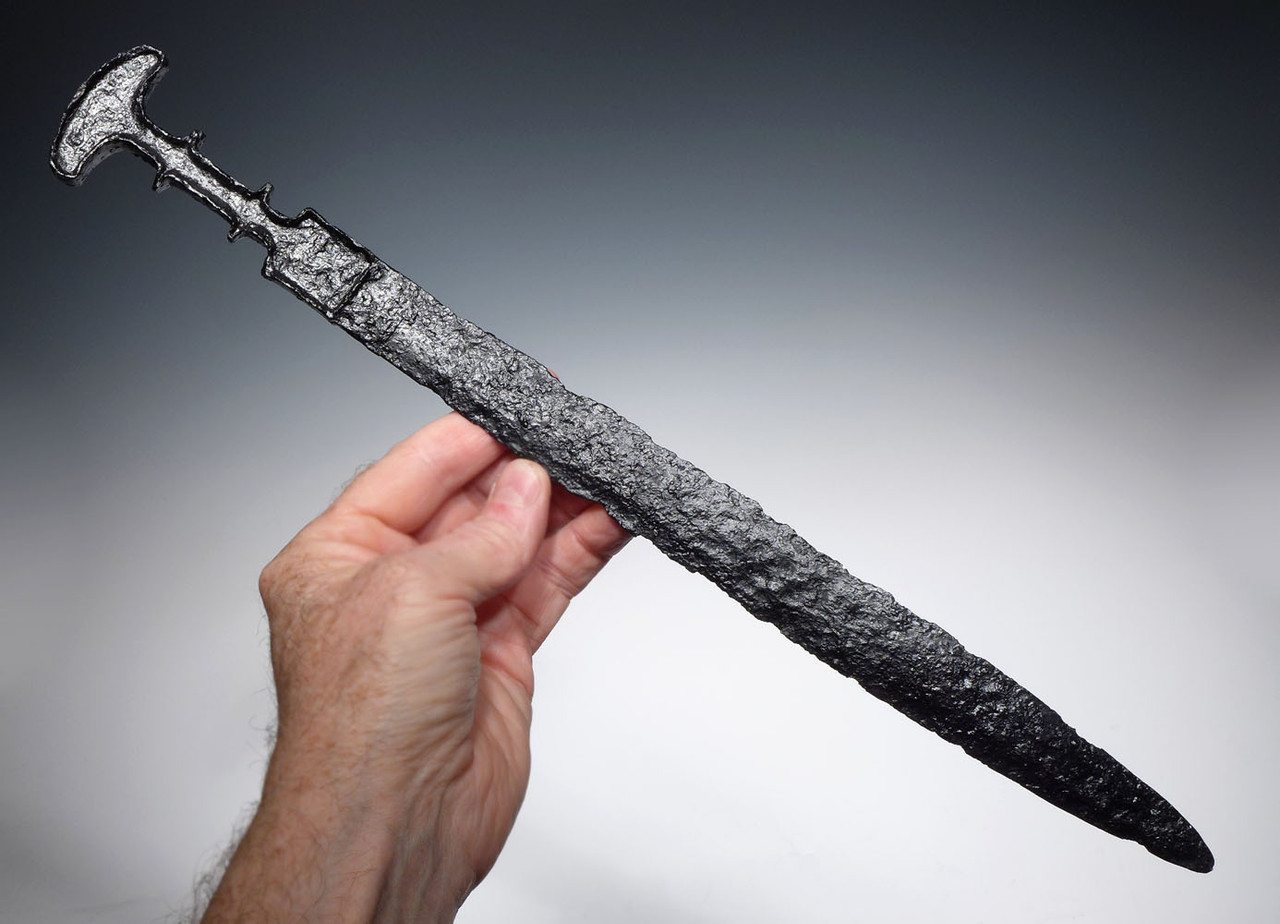Product Description
Dating back from 750 B.C. to 650 B.C., this MUSEUM-CLASS ancient iron Luristan sword originates from the former ancient Near East. It was cast and forged in iron, and features an elaborate integral handle that would have been inlaid with an organic, decorative material such as shell, ivory or bone. It dates to the Iron Age III period and like all ancient iron weapons, is rare to have survived the ravages of time considering it is OVER 2500 years old! Its exceptional preservation and intact condition would make it an especially desirable acquisition to the most advanced collectors and ancient militaria. Very seldom are ancient iron swords from Luristan found in this condition, with very few ever offered on the market.
In ancient times, swords were the most prized and expensive weapon that an soldier could own. Very few owned or carried them because of their excessive cost, therefore, swords were reserved for only the most noble, highest rank and wealthiest warriors. Because of their rarity in the ancient world, authentic swords like this, are similarly the rarest of all ancient weapons to find on the market, making them one of the more promising investment antiquities to own.
This piece has been professionally cleaned and conserved in our lab, being treated with a special sealer developed and formulated by us, specifically for ancient metal preservation. Unlike many ancient swords on the market that are made up of ancient parts of many swords, and include repair and restoration of modern replica parts, this superb example is COMPLETE AND ORIGINAL, with exceptional preservation!
WARNING: There is an ALARMING number of fake ancient artifacts on the market. As fine quality intact, original specimens become more scarce, techniques become more sophisticated to fake these objects. In our lab, we have personally handled numerous extremely well-done forgeries with convincing patinas that could fool most experts. The degree to which the fakers have been able to replicate patina to disguise their work requires an expert examination by highly experienced individuals. Like all rare collectibles, fakes plague the market.
We process every piece we offer to a full analysis, cleaning and conservation process in our on-site lab. How many dealers do this or have any experience in operating their own lab? The procedure we put each piece through is the same as the best museums perform on their own collections. Most dealers lack such knowledge and experience as this, to accurately identify fake and altered ancient objects. Deal only with sources that are extremely knowledgeable in forgeries and altered pieces, and get a written guarantee of authenticity that has no conditions or expiration period. We include this guarantee in writing with every item we sell.
HISTORY
With origins dating back to prehistory, the empire of ancient Iran was one of the world's first superpower civilizations by the time it had taken form in the second millennium B.C.. The various cultures that can be included in the former ancient Iranian Empire stretched across an enormous geographical region extending beyond what is called the Iranian Plateau. To gain insight as to just how large this area was, the Iranian Plateau alone, includes Iran, Afghanistan and Pakistan and comprises approximately nearly 4 million square kilometers (almost 1.5 million square miles). The area of ancient Iran included not only the massive Iranian plateau made up of the tribes of the Medes, Persians, Bactrians and Parthians, but also included groups as far west as the Scythians (an eastern Scythian tribe existed in parallel in Central Asia), Sarmartians, Cimmerians and Alans populating the steppes north of the Black Sea. To the eastern boundary of the empire, the Saka tribes dominated, spreading as far as Xinjiang, China. From a very early period, the ancient Iranian peoples have been historically documented to exist in two separate continuums - a western civilization (Persia) and an eastern civilization (Scythia).
The beginnings of ancient Iran trace back to an influx into the Iranian cultural region of bands of horse-mounted steppe nomads from Central Asia, speaking Indo-European languages. Some settled in eastern Iran but other groups migrated deeper to the west settling in the Zagros Mountains. These first people descended from the proto-Iranians, originating from the Central Asian Bronze age culture of what is called the Bactria-Margiana Complex (aka Oxus Civilization), dated 2200-1700 B.C..
This historical achievements and the breadth of diverse cultures included of this once great empire are too vast to adequately credit in this brief synopsis. The Islamic conquest of Persia in the middle of the 7th century A.D. and the collapse of the Sassanid Empire marked the end of once geographically expansive and culturally diverse ancient superpower.
The term LURISTAN references artifacts made by a society of semi-nomadic people that once lived in the mountainous region of Northwest Iran. Little is known of this ancient culture but the most impressive traces are that of the bronze artifacts they left behind that can be found in parts of present-day Turkey, Iran and Afghanistan. These include highly decorative equipment for their horses, ceremonial containers and numerous weapons ranging from simple utilitarian pieces on up to elaborate masterpieces of warfare.
It is theorized that the Luristan bronzes were crafted by the earliest existence of the Median empire but this has never been proven as written records of the Medes have not survived. The Medes were Indo-Iranian people originally from central Asia who settled in Northwest Iran in the 9th century BC and later defeated the Assyrian empire in 614 BC. Their success is short-lived and their empire which once stretched from central Iran to the Persian Gulf and Anatolia was overrun in 550 BC by the Persians.
CLICK HERE TO SEE MORE ANCIENT NEAR EASTERN LURISTAN ARTIFACTS
 US DOLLAR
US DOLLAR
 EURO
EURO
 AUSTRALIAN DOLLAR
AUSTRALIAN DOLLAR
 CANADIAN DOLLAR
CANADIAN DOLLAR
 POUND STERLING
POUND STERLING
















